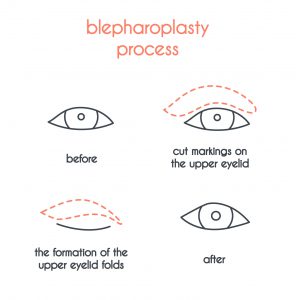Ophthalmic plastic, eyelid surgery, and reconstructive surgery in Farmington and Glastonbury, Connecticut. Oculoplastic or eye plastic surgery is a specialized area of ophthalmology that deals with the treatment of abnormalities of the eyelids, lacrimal system, orbits, and surrounding tissues. An oculoplastic surgeon is an ophthalmologist who has completed additional training in plastic surgery and eyelid surgery as it relates to the eyes and surrounding tissue.
Blepharoplasty, or eyelid surgery, reduces the excess skin, fat, and muscle to create a more youthful appearance. As we age, the skin around our eyes stretches and the muscles weaken, making us look older, tired, or even impair our vision. This commonly occurs with the aging process. Family history and sun exposure may contribute to this process.

Upper eyelid blepharoplasty is a surgical procedure that removes excess skin and fat in the upper eyelids. The excess skin may interfere with vision or result in eyelid fatigue. An incision is made in the natural crease of the eye and skin, muscle and fat are removed.
Ptosis refers to drooping of the upper eyelids, which may affect one or both eyes. When the lid margin falls, it may cover part of the pupil and block the superior field of vision. This may result in eye strain and eyebrow fatigue from an increased effort to elevate the eyelids.
The symptoms are usually worse towards the end of the day and when tired. The usual cause of eyelid drooping is a loosening or stretching of the muscle and tendon that serve to elevate the eyelid. Surgical repair is directed to reattach or shorten the stretched muscle or tendon. The primary goal of ptosis surgery is to elevate the upper eyelid to restore a normal field of vision.
Entropion is a malposition of the eyelid where the eyelid turns inward. When the eyelid turns inward, the lashes rub against the cornea and the result is chronic irritation with a foreign body sensation and discharge. If left untreated, this may lead to infection or ulceration of the cornea.
Ectropion occurs when the lower eyelid turns outward and no longer is in contact with the eye. The lower lid cannot properly spread the tear film across the eye. As a result, the conjunctiva may become dry and inflamed. This results in chronic redness, tearing and irritation.
Ectropion is usually due to relaxation of the eyelid tissue as a result of aging. It may also result from skin cancers, facial nerve paralysis or following lower eyelid or facial surgery.
The usual treatment of ectropion involves tightening of the lower eyelid with repositioning of the lid to its normal position against the eye.
The eye must remain moist in order to retain its health and function. The lacrimal gland is a specialized gland that produces tears. With blinking, the eyelid spreads the tears over the surface of the eye and pumps excess tears into the tear drainage system. There is a delicate balance between enough fluid, too little or too much. The eye may water excessively either due to dryness or obstruction of the outflow of tears from the eye.
The most common cause of tearing is a reflex, which occurs from the drying of the cornea or surface of the eye. If the lacrimal gland fails to produce enough tears, the surface of the eye begins to dry out. This results in symptoms of burning, tearing and irritation. Lubrication will help control the drying and irritation and secondary reflex tearing.
There are also new medications that help the body to produce additional tears and keep the eye comfortable and protected. However, when increased lubrication does not relieve the discomfort, exposure of the tear drainage system with punctal plugs may be beneficial.
Another cause of tearing is an obstruction of the outflow of the tears from the eye. If the lacrimal gland is producing tears properly and the tear drainage system becomes nonfunctioning, the tears will back up and cause the tears to roll down the cheek. Sometimes the existing tear drainage system needs to be corrected and at other times the system needs to be bypassed entirely in order to create a new drainage path for the tears.
Skin cancer can occur anywhere on the skin and often involves the skin of the eyelids or adjacent face. This is due to the thin, sun-exposed areas of the eyelid and surrounding face.
Skin cancers may appear as painless elevations or nodules. Occasionally the eyelashes are distorted or missing. There may be ulcerations of the area, bleeding, crusting and distortion of the normal skin. Any suspicious areas need to be evaluated and may require a biopsy to confirm the diagnosis of skin cancer.
Treatment of eyelid skin cancer involves the complete removal of the tumor followed by reconstruction of the eyelid. Complete removal of eyelid cancer is important to minimize the likelihood of a recurrence or spread of cancer. The oculoplastic surgeon may remove the tumor and have the pathologist check the tissue margins, frozen section, to be sure that the tumor is completely removed.
Another method involves a dermatologist surgeon excising the tumor, Mohs’ technique, to ensure the total removal of cancer. After cancer has been completely removed, reconstructive surgery by an oculoplastic surgeon is usually necessary to preserve the function of the eyelid and obtain the best cosmetic appearance possible.
499 Farmington Avenue, Suite 100
Farmington, CT 06032
Office Telephone: 860-678-0202
295 Western Boulevard
Glastonbury, CT 06033
Office Telephone: 860-678-0202